Egypt
Aswan - 18th - 21st August 2011
We didn't even notice arriving in Aswan so preoccupied were we with getting our visas. The immigration officer was asleep and only roused himself once we docked. We needn't have hurried as it happened since it was a good hour before they let anyone off. Soon we were on our way to our hotel and looking forward to having an air-conditioned retreat from the blistering heat.
Aswan is a lovely place and very laid back. We had a couple of days before we were reunited with the car and we spent them browsing the souk and generally relaxing. We had a lovely evening at Mohammed's house (our fixer) on Elephantine Island which gave us an insight into life in a Nubian village. Apparently the Nubian's regard crocodiles as lucky and many houses have stuffed crocs over the door. Mohammed went one better and had three live ones!
With Mohammed's help the retrieval of the car wasn't too painful, except on the wallet, and Jerry returned from the port with an Egyptian licence and number plates.

Abu Simbel - 22nd - 23rd August 2011
The temples of Abu Simbel are only 50km from Wadi Halfa where we caught the ferry. In fact on our way there we passed a sign to Wadi Halfa. But the road is not open, hence the rigmarole of getting a ferry and putting the car on a barge.
It was not particularly straightforward to get to Abu Simbel either. Tourists are not allowed to drive there unaccompanied and we had to join a convoy. The vast majority of visitors to the temples join the first convoy which leaves Aswan at 4am and then return at 10am. We joined the second convoy at 11am with the plan of staying overnight. It worked out brilliantly; we had the temples completely to ourselves in the evening and were joined by just 4 others for an evening sound and light show. The next morning the temple complex opened at 5am and we watched the sun rise over Lake Nasser. Once again we had the whole place to ourselves until the 4am convoy arrived and disgorged 300 plus tourists.
The temples are quite simply breath-taking. The facade of the Sun Temple consists of four huge statues of Rameses seated on thrones designed to intimidate and terrify strangers when they reached Egypt's borders. Inside the temple the walls and pillars are covered in incredibly detailed frescoes and reliefs depicting famous battles and scenes showing Rameses and his wife with various deities. Nearby is the Hathor Temple erected in honour of his wife Nefertari. The statues that form the facade here all have one leg forward and one recessed as if they are stepping out of the rock face.
 |  |
 |  |
Abu Simbel is yet more amazing for the fact that it was originally about 90m lower than it is today. When the High Dam was built in the early 60's the Nile Valley flooded creating Lake Nasser and many ancient monuments, including Abu Simbel, would have been lost to the lake were it not for an international rescue effort which painstakingly deconstructed and then rebuilt the temples over a period of 4 years.
Luxor - 24th - 27th August 2011
Driving from Aswan we stopped off at Kom Ombo, a temple sited on the banks of the Nile. It was beautiful but the midday sun was so hot we couldn’t explore for long.
Luxor is packed with incredible ancient sites. Our first trip was to Luxor Temple. We went at night which had two advantages - firstly it was cooler (there is little shade in most of the sites and the Egyptian sun is fierce) and secondly it is more peaceful. It gave a different perspective seeing the massive structures and towering statues lit against the dark night.
 |  |
The next day we visited the Valley of the Kings and then the Tombs of the Workers. The tombs at the Valley of the Kings were astonishing. There are 60 odd tombs each sloping sometimes huge distances down into the earth and each intricately decorated. The paint is bright and fresh against what looks like a whitewashed surface and the complexity and diversity of the imagery is engrossing.
Unfortunately your ticket only allows you to see three of the tombs and as we were on a tour we didn't get quite as long to absorb them as we'd have liked but it was still an amazing experience.
It
was even more fascinating to then move on to the Tombs of the Workers.
The artisans who worked on the pharoahs' tombs were segregated in a
village they were never allowed to leave for fear of the highly secret
location of the tombs becoming known. So they spent their spare time excavating and decorating their own tombs - even more
beautifully than those of their masters.
Ever since we did a balloon trip at Sossusvlei in Namibia I have been wanting to repeat the experience and we had the chance to do so for not too much money with a dawn flight over the Theban Necropolis. We were out the door at 4am and being ferried over the Nile not too long afterwards. The view was spectacular - we floated over the Valley of the Kings, the Tombs of the Nobles and Deir el Bahir. We had a longer flight than we expected whilst the pilot searched for somewhere to land amid the heavily farmed land alongside the Nile, eventually touching down in a field being ploughed - much to the surprise of the farmer and his two ox.
 |  |
On our last day in Luxor we visited Karnak, a huge temple complex where you can wander amongst colossal and beautifully carved columns. We have learnt that tourists here aren't early risers. We were first though the gate at 6am and had the enormous site to ourselves for a couple of hours.
 |  |
Dendara and Abydos - 28th August 2011
The next morning we took in our last site in the Theban Necroplois, Deir al Bahir. This huge temple, constructed by Hatshepsut, the only woman to rule during the time of the Pharoahs, is sadly best remembered now for the massacre of tourists by terrorists back in 1997. It is an impressive building but it's real selling point is it's location; it sits within a natural ampitheatre formed by the cliffs behind it.
It was time to leave the valley and we set off up the west bank of the Nile through countless small towns and villages getting lost every so often. Our next stop was Dendara, another temple, this one famous for it's "astronomical ceiling". These were in many temples but the vast majority have lost their roofs over the centuries. This one is not only intact but has been meticulously restored and was truly breathtaking - even if it did give you a cricked neck trying to look at it!
 |  |
 |  |
Our destination for the evening was Abydos. Yet another temple but this one famous for the quality of it's reliefs. Abydos has always attracted spiritualists and new age pilgrims. Whilst this isn't really our cup of tea we were made very welcome by Yvon at the House of Life guesthouse and visited the temple early the next morning. The carving was indeed exquisite - it almost looked carved alabaster and could have been weeks old rather than centuries.
 |  |
 |  |
The Western Desert - El Kharga and Dakhla - 29th August - 1st September 2011
When we arrived at Abydos our hostess had enquired if we had had any problems with the tourist police and we'd answered no. We'd been waved through every roadblock. From here on however they started to take more of an interest and we found ourselves following a police vehicle or with one on our tail all the way. Most frustratingly we had to keep pulling over and waiting for the next leg of our escort to arrive with the result that we got later and later and ended up at our destination in the dark. To be fair the police were courteous and their brief is to look after tourists but we felt a little smothered.
As soon as we turned onto the desert road the police, and most of the other traffic, disappeared. We watched the sun set over the desert as we drove and, as we were late, spent our first evening in El Kharga, the first oasis on our route, in a local hotel.
The next day we went to visit a few of the local sites. First stop was an ancient Christian cemetery – Bagawata. A couple of the tombs are decorated and we picked out various scenes from the bible; Adam and Eve, Jonah and the whale and Moses leading the Israelites amongst them – all looking very much like a 5 year old had got hold of the paint pot and quite a contrast to the precise, graceful lines of images covering the ancient Egyptian monuments we’ve seen.
 |  |
That evening we headed off into the desert and made camp amongst the sand dunes. It was Eid and no doubt in town celebrations for the end of Ramadan were underway but at our desert camp all was quiet.
In the morning we were back on the road and heading for the next oasis, Dakhla. It was a lovely, sleepy little town with an astonishing ancient medieval village made of mud bricks in it's midst. We wandered through winding alleys with huge wooden doors across them which were shut at night for security. A lot of the alley ways are covered and only head height forcing intruders on horse or camel back to dismount.
 |  |
We spent a lovely evening at a beautiful cliff-top camp called the Desert Lodge and the next morning the owner Abdul insisted we had a tour of his orchards. We left laden with freshly picked dates, lemons and guava and had a mint tea at his home before we set off to the next oasis.
 | 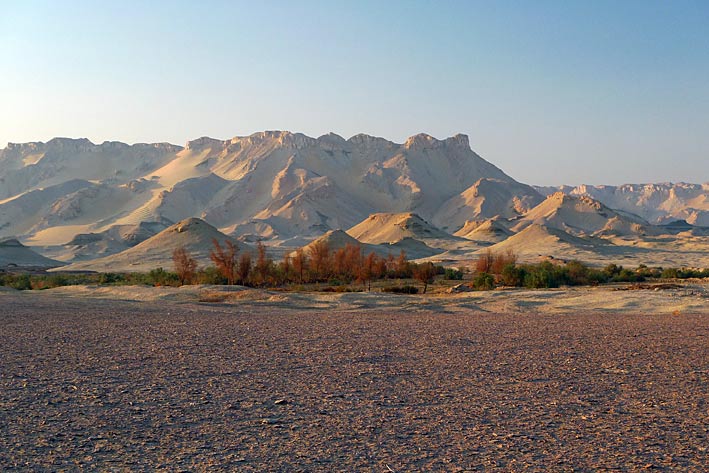 |
 |  |
The Western Desert - Farafra and the White Desert - 2nd - 5th September 2011
The White Desert is probably the most famous destination in the Western Desert, an area filled with calcite formations (calcite apparently consists of compacted sea creatures from when the area was underwater). These rocks have been sculpted into weird and wonderful shapes by the wind and the sand over thousands of years. The landscape is simply jaw-dropping and especially so as the sun rises and sets.
We spent four
nights here, each time camping in different locations and rising at 5.15 am to
watch the sun turn the desert rose and amber.
 |  |
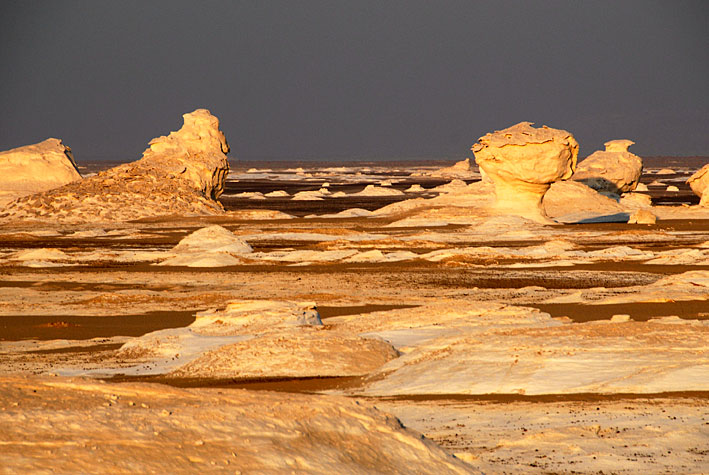 |  |
 |
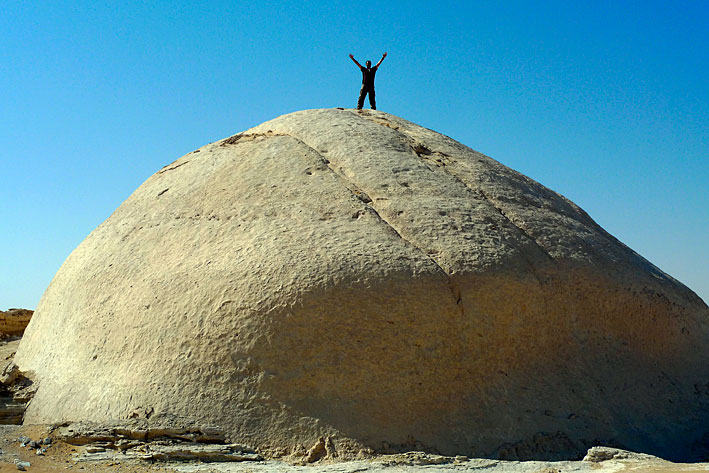 |  |
The days were hot so we spent them at one of the little oases, where Jerry was able to fulfil a life long ambition of stringing his hammock between two palm trees, and only went out into the desert as the sun started to go down.
 |  |
The Western Desert - Bahariya - 6th - 8th September 2011
After the White Desert comes ... you guessed it ... the Black Desert. The terrain is covered by black iron pyrites which top the conical mountains a little like sauce on an ice-cream cone. We spent a few days here, mainly because we were trying to work out how we could get to Siwa Oasis out towards the Libyan border. However, we managed to fit in a few archeological sites, the most interesting of which was a display of some of the mummies removed from the nearby so-called Valley of the Golden Mummies. They have already found around three hundred but believe there may be ten times that still left in the ground. The "golden" is a reference to the masks some of the the wealthier ones have, each individually fashioned to resemble the person in life and with the eyes of the wives dutifully angled to gaze on their husbands for eternity.
 |  |
The Western Desert - Siwa - 9th - 10th September 2011
Siwans don't think of themselves as Egyptians. It is only 65km from the Libyan border and it's inhabitants are in the main descended from the Berber tribes.
It isn't easy to get to Siwa. In theory you have to get permission from the military and then travel with a guide and an armed soldier across the desert. In practice we had to pay a guide for three days of his time to sit with us in the car to Siwa (7 hours) and then the next day he traveled back to Bahariya alone via Cairo (a two day journey) leaving us to enjoy Siwa. He managed to convince the military checkpoint that we didn't need a soldier being the hardened travelers we are but we had to demonstrate our satellite phone worked as part of the deal.
We are staying in a beautiful guest house which is built into, or out of, the walls of the ancient city of Shali. Shali is over a thousand years old and is built from a combination of mud bricks and salt blocks from the local salt lakes. It was lived in up until this century but began to disintegrate after very heavy rains in the late 1920's and is now largely abandoned, though the old mosque is still used. It is a very atmospheric place with the calls to prayer echoing through the ruins.
 |  |
Alexandria - 11th - 16th September 2011
Our introduction to Alex was pretty stressful. Drivers are insane and pedestrians only slightly less so. However, leaving Jerry in the car I set out on foot to find us a hotel and came up with a gem with a balcony overlooking the sweeping bay. There are ancient ruins and great restaurants and the whole feel is a bizarre mix of western and eastern.
We have visited the Catacombs of Kom es Shoqafa - weird and wonderful! And the new Biblioteque - very impressive.
On the minus side too much time, and much too much money, here was spent trying to extend the papers for the car. Generally we have encountered little in the way of corruption/baksheesh demands in Egypt but our experience here left a rather sour taste.
 |  |
El Alamein and Wadi Natron - 17th September 2011
Jerry was particularly keen to visit El Alamein so we headed west out of Alex and back along the road we'd driven a week ago. The Museum was well-intentioned but a little tired. It did have some interesting exhibits though. I particularly liked the contents of a Desert Rat's standard kit bag. We also visited the Commonwealth War Cemetery which was beautifully done and very affecting.
On our way south to Cairo we stopped off at Wadi Natron. Even if we hadn't been intending to we would have had little choice as the car developed a sudden and emphatic flat tire. We took refuge at El Hamra Eco-Lodge and spent a very enjoyable evening in the company of the owner General Hany El-Kamouny. The next day we visited one of the nearby Christian monasteries, Deir Anba Bishoi, which dates back to 300AD and were shown around by one of the monks. We saw the monks' cells and refrectory and, on a more gruesome note, the ancient well where the well where the Berber tribesmen washed their swords after massacring one lot of monks back in 444.
Cairo to Wadi El Rayyan and back to Cairo - 18th - 23rd September 2011
We set off towards Cairo with some trepidation. There is lots to see and do there but the road network and suicidal driving there are infamous. We found our way to the campsite without too much grief then decided to try and recce the pyramids at Giza for the following day. This was not much fun. We arrived to find them shut - which we thought would be the case - but it didn't stop the hawkers trying to sell us a camel/horse/whatever ride. To add insult to injury a taxi drove into us on the way home. We were hardly moving at the time and he was determined to get into our lane. As there was no damage we both drove away. However we decided to visit Giza by taxi the next day.
To be honest Giza was a little disappointing. Yes the pyramids are amazing. Some of the statistics are mind-boggling. 4500 years old, built using 2,300,000 blocks weighing an average of 2 tonnes each. But the place was heaving with coaches, minibuses and camels and it didn't really allow you to absorb the real wonder of it all.
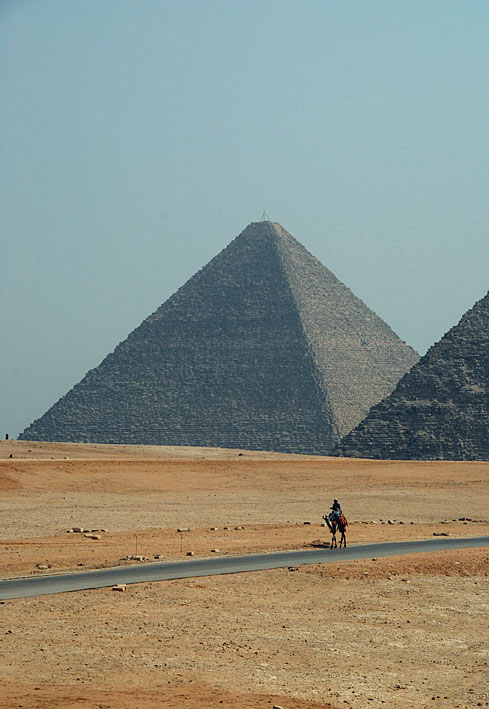 |  |
Having had our fill of Cairo for the moment we decided to head off to the Fayoum which is part of the Western Desert. We extricated ourselves from Cairo's road system and set out towards Wadi El Rayyan, a protected area around some large lakes. The scenery was beautiful with sand dunes and desert surrounding vivid turquoise water. However, we couldn't find the designated campsite promised in the book and on the map so we set off deeper into the desert Wadi El Hitan, the Valley of the Whales.
This turned out to be an amazing spot and one of our favorite in the whole of Egypt. The name comes from the extremely rich cache of marine fossils found in the valley which was at some point about 40 million years ago, a bay on the coast of a long disappeared sea. Now a World Heritage Site you can take a walk through the area with various skeletons and fossilized remains marked out along the way. The site is particularly special because many of the skeletons showed the whales, the ancestors of those that cross our oceans today, had back legs, proving that whales were once land mammals that returned to the sea at some point in their evolution.
 |  |
 | 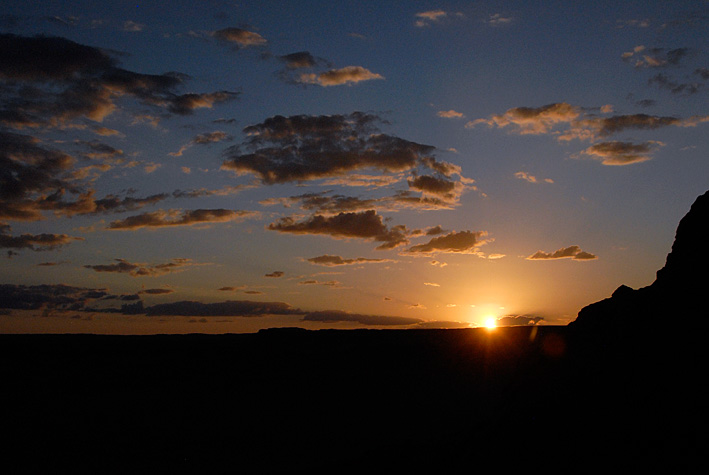 |
We braved the road back to Cairo bu en route took in some more pyramids at Dashur. We got a little lost on the way. There was a clearly signposted tar road ... but apparently only for military use so we were directed to take the next turn off. This took us along a works road very much in use by workers building some kind of enormous pipeline. But everyone smiled and waved so we carrid on. At the other end - pyramids in view all around us - we found ourselves in some kind of military zone with rather ominous skull and cross bones signs but we persevered and eventually arrived "cross-country" having managed to bypass the entry gate. These pyramids were much more enjoyable. The Red Pyramid (second biggest after Cheops) is open and you can clamber down the steep shaft into the tomb itself. An amazing experience though a little claustrophobic. The so-called Bent Pyramid is equally interesting. It's angle was changed half way through the build after others had imploded under their own weight.
 |  |
Sharm El Sheik to Dahab, St Catherines and Nuweiba - 24th September- 10th October 2011
The next plan was to head to Sinai for some diving. We left Cairo a little late and went through the tunnel under the Suez Canal a little late and finally ended up trying to find a hotel in Sharm in the dark. Which wasn't much fun. The next day - slightly overcome by the glitz and glamour of Sharm - we decided to retire to Ras Mohammed National Park for some breathing space. The park was pretty full of tour buses but we found a little spot on the beach in a bay around the coast from the main action and weren't bothered by anyone. The park still has the remains of trenches and shelters from the Israeli occupation back in the 60's.
We then skipped up the coast to Dahab. This was far more our cup of tea - a very laid back spot with some nice restaurants. We spent a few days diving along the coast but then Jerry started having some problems with his ears so we headed inland.
 |  |
St Catherines, at the foot of Mount Sinai, is a small, quiet own. Most people come to St Catherines to climb the mountain, often to see the sunrise. However, we'd been told it's busy at that time with up to 500 people at the top so opted to walk up for sunset. We went a back route and saw no-one else until we reached the summit. We stopped off at our bedouin guide's family home en route for a cup of tea. They were excited to see that the walking map we had just bought had a photo of one of their other sons on the cover. The climb was tough, especially the 750 rock hewn steps to the very top. But the view worth it.
Of course being there for sunset meant that the 1.5 hours back was in the dark but the moon was 3/4s full and we didn't need a torch. It was an eerie experience walking down the mountain in the moonlight.
 |  |
After our exertions we headed back to the coast and found a nice beach hut just north of Nuweiba where we settled down for a few days of planning for Jordan and the occasional snorkle in the turquoise water.